

Crazy Medieval Medical Practices We Still Use. Medieval times were dark and without reason, or at least that’s what we’re taught to think.

But contrary to this popular belief, many of our common medical practices have roots in this period. Of course the treatments have been refined and the instruments standardized, but many practices are relatively unchanged. So if you’ve ever wondered about the origins of modern medical procedures, check out our list of amazing ones from the Middle Ages which we still use today: #1 Bloodletting A.K.A Phlebotomy We’re all shocked and disgusted when we hear about medieval bloodletting, but this seemingly crazy practice is still used today. 13 Strange Superstitions: Bizarre Beliefs from Around the World.
Old English literature. Old English literature or Anglo-Saxon literature, encompasses literature written in Old English, in Anglo-Saxon England from the 7th century to the decades after the Norman Conquest of 1066.

"Cædmon's Hymn", composed in the 7th century, according to Bede, is often considered the oldest extant poem in English, whereas the later poem, The Grave is one of the final poems written in Old English, and presents a transitional text between Old and Middle English. The Peterborough Chronicle can also be considered a late-period text, continuing into the 12th century. The poem Beowulf, which often begins the traditional canon of English literature, is the most famous work of Old English literature. The Anglo-Saxon Chronicle has also proven significant for historical study, preserving a chronology of early English history. Besides Old English literature, Anglo-Saxons wrote a number of Anglo-Latin works. English Medieval Literature. Medieval Literature. Medieval Narrative: Backgrounds of Medieval Literature. The Carnival Spirit in Medieval Europe The social structures dominating life in medieval Europe drew attention to the figures on top of the hierarchical ladders --kings and popes, lords and ladies, chivalric heroes--and to the institutions they represented and sustained.

But since life at the bottom of the ladder exists as well, a remarkably vibrant counter-culture challenged the orthodox vision. Side by side with serious epic poems, for example, appeared mock epics, often in the form of beast fables whose talking animals ridicule or parody the highflown utterances of traditional heroes. On every great Gothic cathedral, next to exquisite stained glass windows and rows of statued saints, lurk grotesque gargoyles, twisted, shocking, and amusing figures that entwine animal and human forms. Introduction to Middle English Literature: The Medieval World. The Church The most important philosophical influence of the Middle Ages was the Church, which dominated life and literature.
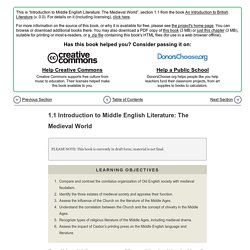
In medieval Britain, “the Church” referred to the Roman Catholic Church. Medieval Political Philosophy. 1.
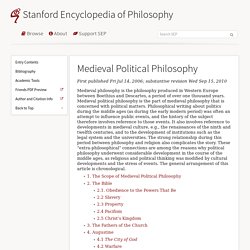
The Scope of Medieval Political Philosophy “Medieval” refers primarily to Europe (the term being applied to other cultures by analogy). Medieval philosophy includes the “pre-scholastic”, “scholastic” and “late scholastic” periods. History - Ancient History in depth: Peoples of Britain. English people. The English are a nation and an ethnic group native to England, who speak the English language.

The English identity is of early medieval origin, when they were known in Old English as the Angelcynn ("family of the Angles"). Their ethnonym is derived from the Angles, one of the Germanic peoples who migrated to Great Britain around the 5th century AD.[6] England is one of the countries of the United Kingdom. Today many English people have recent forebears from other parts of the United Kingdom, while some are also descended from more recent immigrants from other European countries and from the Commonwealth. Why was the pope a powerful person in medieval Europe? Famous Medieval People. When looking at famous medieval people there really is a lot of ground to cover.
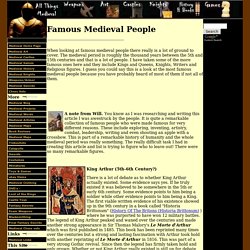
The medieval period is roughly the thousand years between the 5th and 15th centuries and that is a lot of people. I have taken some of the more famous ones here and they include Kings and Queens, Knights, Writers and Religious figures. I guess you could say this is a look at the most famous medieval people because you have probably heard of most of them if not all of them. Who's Who in Medieval England and Wales. Why was the church so powerful in medieval times. 1st Answer One reason the church was so powerful was the fact that clerics (church officials) were largely the only ones who could read.
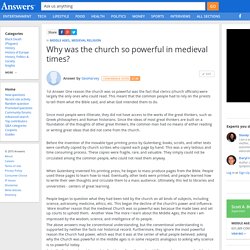
This meant that the common people had to rely on the priests to tell them what the Bible said, and what God intended them to do. Since most people were illiterate, they did not have access to the works of the great thinkers, such as Greek philosophers and Roman historians. England in the Middle Ages. The Norman invasion of England in 1066 led to the defeat and replacement of the Anglo-Saxon elite with Norman and French nobles and their supporters.

William the Conqueror and his successors took over the existing state system, repressing local revolts and controlling the population through a network of castles. The new rulers introduced a feudal approach to governing England, eradicating the practice of slavery but creating a much wider body of unfree labourers called serfs. Middle Ages. Period of European history from the 5th to the 15th century In the history of Europe, the Middle Ages (or medieval period) lasted from the 5th to the 15th century.
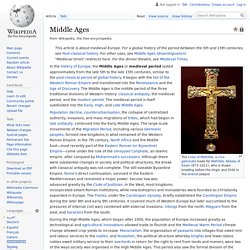
It began with the fall of the Western Roman Empire and merged into the Renaissance and the Age of Discovery.